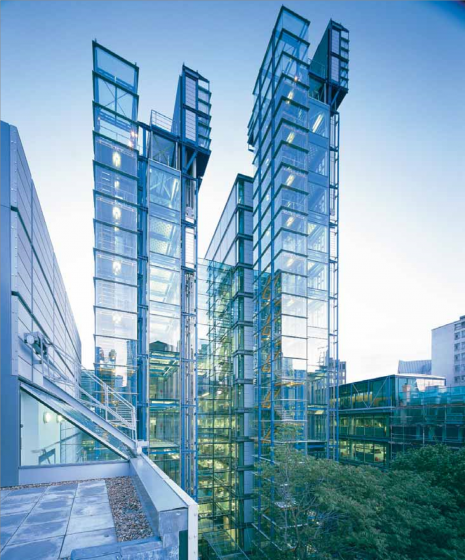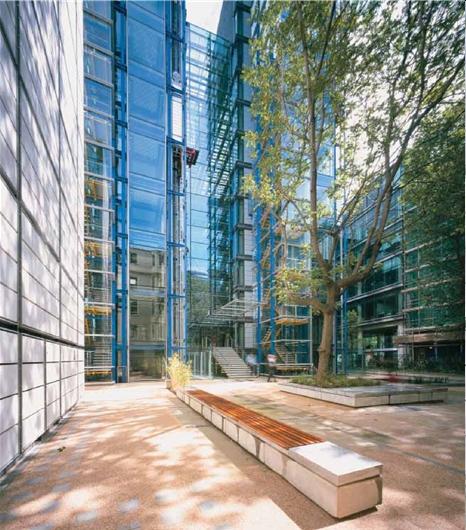Lloyd's Register
Clarity of architectural language is the key to this development, where the function of all constituent elements is celebrated, revealing the secrets of their manufacture and operation.
Lloyd’s Register is an old-established City institution, its Fenchurch Street headquarters the centre of a worldwide operation. The growth of the business during the 1980s led Lloyd’s Register to commission Richard Rogers Partnership (RRP, now Rogers Stirk Harbour + Partners, RSH+P) to prepare proposals for redeveloping its City site. Set within a conservation area, access to the headquarters is through a landscaped churchyard. The site is surrounded by existing buildings, including 71 Fenchurch Street constructed for Lloyd’s Register in 1901.
This Grade II listed building has been incorporated into the new headquarters and extensively restored. The new building comprises fourteen stories of office space and two basements. The floorplates taper in response to the awkward geometry of the site, creating a fan-shaped grid composed of vaults formed around two atria spaces.
This design allows daylight penetration and provides thermal buffers between the offices and the exterior. The building steps up from six to fourteen levels within the centre of the site. Service cores are expressed as towers – two primary circulation cores face the churchyard, while secondary cores to the rear house toilets, goods lifts, staircases, and the main services risers. Highly transparent glazing offers instant legibility – people using the fully glazed wall-climber lifts and stairs animate the building’s exterior.
The glazed façade is designed to maximise daylight while limiting solar heat gain in summer and heat losses in winter. In addition to double glazing, the east and west facades feature panels of motorised louvres. Activated by photo-cells mounted at roof level, when the louvres are angled at 45 degrees the facade system reduces solar heat gain by 90 per cent. Chilled beams incorporating sprinklers, lighting and a PA system cool the air in the office space. The building’s energy efficiency means a reduction of carbon-dioxide emissions by 33 per cent and costs by 40 per cent when compared with a conventionally air conditioned building.
Project information:
- Place/Date: London, England 1993 - 2000
- Client: Lloyd’s Register
- Cost: £70 million
- Area: 34,000 m²
- Architect: Richard Rogers Partnership
- Structural Engineer: Anthony Hunt Associates
- Services Engineer: Ove Arup & Partners
- Quantity Surveyor: AYH Partnership
- Project Manager: Richard Ellis
- Landscape Architect: Edward Hutchison
- Lighting Consultant: Lighting Design Partnership
- Planning Consultant: Montagu Evans
- Fire Consultant: Warrington Fire Research Consultants
- Main Contractor: Sir Robert McAlpine & Sons Ltd
Awards:
- World Architecture Award for Best Commercial Building in the World, 2002
- Civic Trust Award, 2002
- RIBA Award/Stirling Prize Shortlist, 2002
- Aluminium Imagination Awards – Commendation, 2001
- Concrete Society Certificate of Excellence ‘Building Category’, 2000
--RSHP
[edit] Related articles on Designing Buildings Wiki
- 3 World Trade Center.
- 8 Chifley.
- 88 Wood Street.
- BBVA Bancomer headquarters.
- Centre Building at LSE shortlisted for RIBA award.
- Concept architectural design.
- International Towers Sydney.
- Leadenhall Building.
- Lloyd's of London.
- One Park Taipei.
- RSHP
- Skyscraper.
- Taiwan Taoyuan International Airport Terminal 3.
Featured articles and news
International Electrician Day, 10 June 2025
Celebrating the role of electrical engineers from André-Marie Amperè, today and for the future.
New guide for clients launched at Houses of Parliament
'There has never been a more important time for clients to step up and ...ask the right questions'
The impact of recycled slate tiles
Innovation across the decades.
EPC changes for existing buildings
Changes and their context as the new RdSAP methodology comes into use from 15 June.
Skills England publishes Sector skills needs assessments
Priority areas relating to the built environment highlighted and described in brief.
BSRIA HVAC Market Watch - May 2025 Edition
Heat Pump Market Outlook: Policy, Performance & Refrigerant Trends for 2025–2028.
Committing to EDI in construction with CIOB
Built Environment professional bodies deepen commitment to EDI with two new signatories: CIAT and CICES.
Government Grenfell progress report at a glance
Line by line recomendation overview, with links to more details.
An engaging and lively review of his professional life.
Sustainable heating for listed buildings
A problem that needs to be approached intelligently.
50th Golden anniversary ECA Edmundson apprentice award
Deadline for entries has been extended to Friday 27 June, so don't miss out!
CIAT at the London Festival of Architecture
Designing for Everyone: Breaking Barriers in Inclusive Architecture.
Mixed reactions to apprenticeship and skills reform 2025
A 'welcome shift' for some and a 'backwards step' for others.
Licensing construction in the UK
As the latest report and proposal to licence builders reaches Parliament.
Building Safety Alliance golden thread guidance
Extensive excel checklist of information with guidance document freely accessible.
Fair Payment Code and other payment initiatives
For fair and late payments, need to work together to add value.
Pre-planning delivery programmes and delay penalties
Proposed for housebuilders in government reform: Speeding Up Build Out.
High street health: converting a building for healthcare uses
The benefits of health centres acting as new anchor sites in the high street.



























